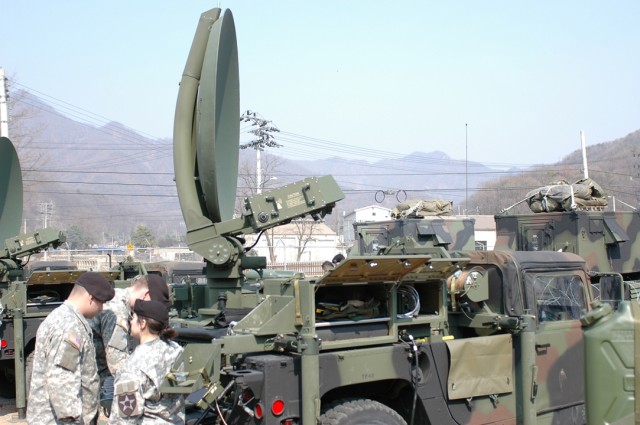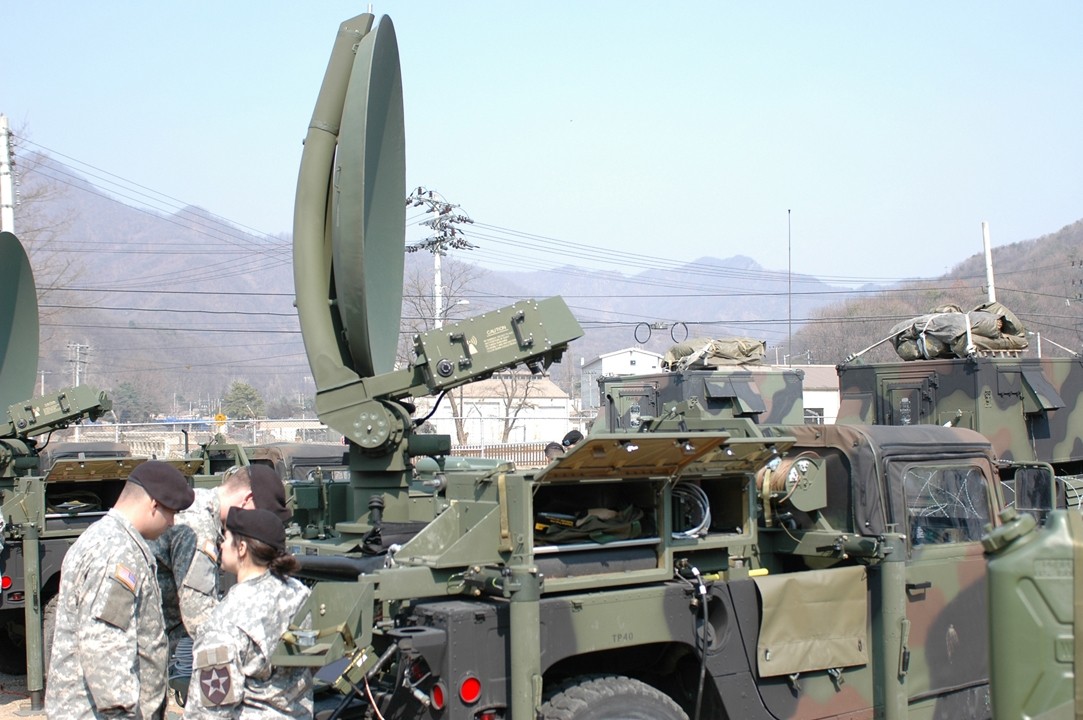CAMP CASEY -- Signal Soldiers from the 2nd Infantry Division set up near Story Barracks March 14-16 to validate a new satellite communications terminal.
Called Secure, Mobile, Anti-jam, Reliable, Tactical Terminal, the equipment was tested before it gets dispersed throughout the division to units like 1st Heavy Brigade Combat Team and 2nd Combat Aviation Brigade.
SMART-T is a Military Strategic and Tactical Relay satellite communications terminal that transmits and receives data and voice information.
Mounted on High Mobility Multi-purpose Wheeled Vehicles, SMART-T receives data from a node center, which is a switching, multiplexing, and communications security equipment that supports secure digital communications, and transmits the data to a MILSTAR satellite. The MILSTAR satellite then sends the data back down to another SMART-T that is plugged into another node center.
SMART-T is reliable and helps strengthen 2ID combat power due to its high communication capacity compared to conventional equipment. The terminal provides voice and data communications at low to medium rates. It operates at speeds up to 1.544 megabytes per second over a MILSTAR satellite. An 8 x 10-inch image can be sent in two minutes using SMART-T, whereas it used to take as long as 22 hours.
SMART-T has been successfully used in Afghanistan and Iraq, where terrain can limit line-of-sight communications using conventional antennas. With a HMMWV's mobility and the satellite's ability to overcome line-of-sight communications, SMART-T provides flexibility in communicating information in various types of terrain.
"It's beyond line-of-sight," said Warrant Officer Michael Bailey, HHC, 2ID G6 Plans and Engineering. "Hop over a mountain, all the way around the world. It transports whatever communication pieces you put on it."
SMART-T is almost self-run equipment that is user-friendly and its setup time is reduced.
"It's smart because it pretty much works by itself," said Sgt. Matthew Koenig, Co. A, DSTB, SMART-T operator. "All you have to do is, when you bring it up, actuate it to the satellite."
"COMSEC that is loaded into SMART-T changes over every month," Koenig continued. "We don't have to shut it down, reload COMSEC and bring it back up on the system. It just changes over."
Though this is not new equipment to the Army, it is new to Korea and 2ID. Its compatibility to work with both Mobile Subscriber Equipment and Joint Network Node, which are current and future equipment is an advantage.
"Most of the Army MSE now has been replaced with JNN equipment," said Staff Sgt. Maxwell Smith, HHC, 2ID G6 operations NCO. "The SMART-T is a piece of that upgrade equipment that can integrate into both the MSE and JNN networks."
Communication security is always a priority when it comes to military communications. One of SMART-T's features is 'anti-jam.'
"Not only the MILSTAR satellite that's up there, but also the terminal itself can't be jammed," Bailey said. "The stuff it does is classified. Nothing can stop it from transmission."
When the SMART-T gets distributed to echelons below 2ID, the units will be equipped with a more advanced and effective communications system. More than 70 percent of terrain on the Korean peninsula is mountainous. SMART-T will be very useful when it comes to commo missions to defend the land from any possible aggression.


Social Sharing